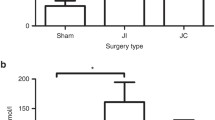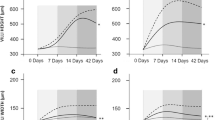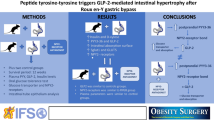Abstract
Glucagon-like peptide-2 (GLP-2) is an enteroendocrine hormone which is uniquely trophic for the intestine; a physiological role in regulating nutrient absorptive capacity is becoming apparent. GLP-2, independent of enteral feeding, stimulates a classical pattern of intestinal adaptation in terminal ileum following resection. Herein we investigate the effects of GLP-2 on the jejunal remant using a rat model of short bowel syndrome (SBS). Juvenile 250- to 275-g SD rats underwent 80% distal small bowel resection, leaving 20 cm of proximal jejunum and venous catheterization. Animals were maintained with total parenteral nutrition (TPN) or TPN+10 μg/kg/hr GLP-2 (n=8 per group). After 7 days, intestinal permeability was assessed by urinary recovery of gavaged carbohydrate probes. Animals were euthanized, and the intestines taken for analysis of morphology, crypt cell proliferation, apoptosis, and expression of SGLT-1 and GLUT-5 transport proteins. GLP-2 treatment reduced intestinal permeability and increased in vivo glucose absorption, small intestinal weight, surface area, villus height, crypt depth, and microvillus height. Intestinal mucosal DNA and protein content per unit length of the small bowel were increased (P < 0.05 for all comparisons). However, in contrast to previous studies examining GLP-2’s effects on remnant ileum, the jejunal crypt apoptotic index was increased in GLP-2-treated animals, with no increase in SGLT-1 or GLUT 5 expression. These results show that exogenous GLP-2 treatment of animals with jejunal remnant reduces intestinal permeability, increases glucose absorption, and stimulates morphological features of intestinal adaptation including increased micovillus height and surface area. However, the pattern of changes seen is different from that in remnant ileum. This suggests that GLP-2’s effects are specific to different regions of the bowel. Nonetheless, remnant jejunum is responsive to GLP-2 in the absence of enteral nutrition. Further studies are warranted to establish the mechanisms of action and therapeutic potential of GLP-2 in modulating nutrient absorptive capacity.





Similar content being viewed by others
References
Dowling RBC (1967) Structural and functional changes following small intestinal resection in the rat. Clin Sci 32:139–143
Sigalet DL (2001) Short bowel syndrome in infants and children: an overview. Semin Pediatr Surg 10(2):49–55
Williamson RC (1978) Intestinal adaptation I and II. N Engl J Med 298:1393–1450
Mayo KE, Miller LJ, Bataille D, et al. (2003) International Union of Pharmacology. XXXV. The glucagon receptor family. Pharmacol Rev 55(1):167–194
Brubaker PL, Izzo A, Hill M, Drucker DJ (1997) Intestinal function in mice with small bowel growth induced by glucagon-like peptide-2. Am J Physiol 272(6, Pt 1):E1050–E1058
Drucker DJ, Erlich P, Asa SL, Brubaker PL (1996) Induction of intestinal epithelial proliferation by glucagon-like peptide 2. Proc Natl Acad Sci USA 93(15):7911–7916
Orskov C, Holst JJ, Knuhtsen S, Baldissera FG, Poulsen SS, Nielsen OV (1986) Glucagon-like peptides GLP-1 and GLP-2, predicted products of the glucagon gene, are secreted separately from pig small intestine but not pancreas. Endocrinology 119(4):1467–1475
Roberge JN, Brubaker PL (1991) Secretion of proglucagon-derived peptides in response to intestinal luminal nutrients. Endocrinology 128(6):3169–3174
Rocca AS, Brubaker PL (1999) Role of the vagus nerve in mediating proximal nutrient-induced glucagon-like peptide-1 secretion. Endocrinology 140(4):1687–1694
Drucker DJ (2002) Biological actions and therapeutic potential of the glucagon-like peptides. Gastroenterology 122(2):531–544
Sigalet DL (2001) ALX-0600 (NPS Allelix Corp). Curr Opin Invest Drugs 2(4):505–509
Brubaker PL, Schloos J, Drucker DJ (1998) Regulation of glucagon-like peptide-1 synthesis and secretion in the GLUTag enteroendocrine cell line. Endocrinology 139(10):4108–4114
Martin GR, Wallace LE, Hartmann B, et al. (2005) Nutrient-stimulated GLP-2 release and crypt cell proliferation in experimental short bowel syndrome. Am J Physiol Gastrointest Liver Physiol 288(3):G431–G438
Bozkurt A, Naslund E, Holst JJ, Hellstrom PM (2002) GLP-1 and GLP-2 act in concert to inhibit fasted, but not fed, small bowel motility in the rat. Regul Pept 107(1–3):129–135
Ljungmann K, Hartmann B, Kissmeyer-Nielsen P, Flyvbjerg A, Holst JJ, Laurberg S (2001) Time-dependent intestinal adaptation and GLP-2 alterations after small bowel resection in rats. Am J Physiol Gastrointest Liver Physiol 281(3):G779–G785
Munroe DG, Gupta AK, Kooshesh F, et al. (1999) Prototypic G protein-coupled receptor for the intestinotrophic factor glucagon-like peptide 2. Proc Natl Acad Sci USA 96(4):1569–1573
Bjerknes M, Cheng H (2001) Modulation of specific intestinal epithelial progenitors by enteric neurons. Proc Natl Acad Sci USA 98:12497–12502
Wallace LE, Martin G, Swain MG, Sharkey KA, Sigalet DL (2004) Acute GLP-2 treatment induces effects in both peripheral and central nervous systems. Can J Gastroenterol 18:A120
Ramsanahie A, Duxbury MS, Grikscheit TC, et al. (2003) Effect of GLP-2 on mucosal morphology and SGLT1 expression in tissue-engineered neointestine. Am J Physiol Gastrointest Liver Physiol 285(6):G1345–G1352
Rocha FG, Shen KR, Jasleen J, et al. (2004) Glucagon-like peptide-2: divergent signaling pathways. J Surg Res 121(1):5–12
Walsh NA, Yusta B, DaCambra MP, Anini Y, Drucker DJ, Brubaker PL (2003) Glucagon-like peptide-2 receptor activation in the rat intestinal mucosa. Endocrinology 144(10):4385–4392
Yusta B, Huang L, Munroe D, et al. (2000) Enteroendocrine localization of GLP-2 receptor expression in humans and rodents. Gastroenterology 119(3):744–755
Cheeseman CI (1997) Upregulation of SGLT-1 transport activity in rat jejunum induced by GLP-2 infusion in vivo. Am J Physiol 273(6, Pt 2):R1965–R1971
Guan X, Stoll B, Lu X, et al. (2003) GLP-2-mediated up-regulation of intestinal blood flow and glucose uptake is nitric oxide-dependent in TPN-fed piglets. Gastroenterology 125(1):136–147
Martin GR, Wallace LE, Sigalet DL (2004) Glucagon-like peptide-2 induces intestinal adaptation in parenterally fed rats with short bowel syndrome. Am J Physiol Gastrointest Liver Physiol 286(6):G964–G972
O’Brien DP, Nelson LA, Huang FS, Warner BW (2001) Intestinal adaptation: structure, function, and regulation. Semin Pediatr Surg 10(2):56–64
Jeppesen PB, Hartmann B, Hansen BS, Thulesen J, Holst JJ, Mortensen PB (1999) Impaired meal stimulated glucagon-like peptide 2 response in ileal resected short bowel patients with intestinal failure. Gut 45(4):559–563
Sigalet DL, Martin G, Meddings J, Hartman B, Holst JJ (2004) GLP-2 levels in infants with intestinal dysfunction. Pediatr Res 56(3):371–376
Topstad D, Martin G, Sigalet D (2001) Systemic GLP-2 levels do not limit adaptation after distal intestinal resection. J Pediatr Surg 36(5):750–754
Meddings JB, Gibbons I (1998) Discrimination of site-specific alterations in gastrointestinal permeability in the rat. Gastroenterology 114(1):83–92
Martin GR, Meddings JB, Sigalet DL (2003) 3-O Methylglucose absorption in vivo correlates with nutrient absorption and intestinal surface area in experimental short bowel syndrome. J Parenter Enteral Nutr 27(1):65–70
Menge H, Hopert R, Alexopoulos T, Riecken EO (1982) Three-dimensional structure and cell kinetics at different sites of rat intestinal remnants during the early adaptive response to resection. Res Exp Med (Berl) 181(2):77–94
Sigalet DL, Martin GR, Poole A (2000) Differential sugar absorption as a marker for adaptation in short bowel syndrome. J Pediatr Surg 35(5):661–664
Chung BM, Wong JK, Hardin JA, Gall DG (1999) Role of actin in EGF-induced alterations in enterocyte SGLT1 expression. Am J Physiol 276(2, Pt 1):G463–G469
Buret A, Gall DG, Olson ME (1991) Growth, activities of enzymes in the small intestine, and ultrastructure of microvillus border in gerbils infected with Giardia duodenalis. Parasitol Res 77(2):109–114
Cohn SM, Lieberman MW (1984) The use of antibodies to 5-bromo-2’-deoxyuridine for the isolation of DNA sequences containing excision-repair sites. J Biol Chem 259(20):12456–12462
Potten CS, Loeffler M (1990) Stem cells: attributes, cycles, spirals, pitfalls and uncertainties. Lessons for and from the crypt. Development 110(4):1001–1020
Musckhelishvili L, Latendresse JR, Kodell RL, Henderson EB (2003) Evaluation of cell proliferation in rat tissues with BrdU, PCNA, Ki-67(MIB-5) immunohistochemistry and in situ hybridization for histone mRNA. J Histochem Cytochem 51(12):1681–1688
Marshman E, Ottewell PD, Potten CS, Watson AJM (2001) Caspase activation during spontaneous and radiation–induced apoptosis in the murine intestine. J Pathol 195:285–292
Lowry OH, Rosebrough NJ, Farr AL, Randall RJ (1951) Protein measurement with the Folin phenol reagent. J Biol Chem 193(1):265–275
Dunphy JL, Justice FA, Taylor RG Fuller PJ (1999) mRNA levels of dipeptidyl peptidase IV decrease during intestinal adaptation. J Surg Res 87:130–133
Burrin DG, Stoll B, Jiang R, et al. (2000) GLP-2 stimulates intestinal growth in premature TPN-fed pigs by suppressing proteolysis and apoptosis. Am J Physiol Gastrointest Liver Physiol 279(6):G1249–G1256
Ramsanahie AP, Berger UV, Zinner MJ, Whang EE, Rhoads DB, Ashley SW (2004) Effect of glucagon-like peptide-2 (GLP-2) on diurnal SGLT1 expression. Dig Dis Sci 49(11–12):1731–1737
Jarboe MD, Juno RJ, Bernal NP, et al. (2004) Bax deficiency rescues resection-induced enterocyte apoptosis in mice with perturbed EGF receptor function. Surgery 136(2):121–126
Knott AW, O’Brien DP, Juno RJ, et al. (2003) Enterocyte apoptosis after enterectomy in mice is activated independent of the extrinsic death receptor pathway. Am J Physiol Gastrointest Liver Physiol 285(2):G404–G413
Dahly EM, Guo Z, Ney DM (2002) Alterations in enterocyte proliferation and apoptosis accompany TPN-induced mucosal hypoplasia and IGF-I-induced hyperplasia in rats. J Nutr 132(7):2010–2014
Tsai CH, Hill M, Asa SL, Brubaker PL, Drucker DJ (1997) Intestinal growth-promoting properties of glucagon-like peptide-2 in mice. Am J Physiol 273:E77–E84
Yusta B, Boushey RP, Drucker DJ (2000) The glucagon-like peptide-2 receptor mediates direct inhibition of cellular apoptosis via a cAMP-dependent protein kinase-independent pathway. J Biol Chem 275(45):35345–35352
Marshman E, Booth C, Potten CS (2002) The intestinal epithelial stem cell. BioEssays 24:91–98
Kouris GJ, Liu Q, Rossi H, et al. (2001) The effect of glucagon-like peptide 2 on intstinal permeability and bacterial translocation in acute necrotizing pancreatitis. Am J Surg 181:571–575
Sigalet DL, Martin G, Meddings J (2004) 3-O Methylglucose absorption in vivo correlates with nutrient aborption and intestinal surface area in experimental short bowel syndrome. JPEN J Parenter Enteral Nutr 28:158–162
Scott RB, Kirk D, MacNaughton WK, Meddings JB (1998) GLP-2 augments the adaptive response to massive intestinal resection in rat. Am J Physiol 275(5, Pt 1):G911–G921
Dahly EM, Gillinham MB, Guo Z, et al. (2003) Role of luminal nutrients and endogenous GLP-2 in intestinal adaptation to mid-small bowel resection. Am J Physiol Gastrointest Liver Physiol 284:G670–G682
Acknowledgments
This study was supported by funding from the Alberta Children’s Hospital Research Foundation. We thank NPS Pharmaceuticals for provision of GLP-2 and performance of assays and Lidia Demchyshyn for support. Thanks are also due to Gail Wright-Wilson for secretarial support.
Author information
Authors and Affiliations
Corresponding author
Rights and permissions
About this article
Cite this article
Sigalet, D.L., Bawazir, O., Martin, G.R. et al. Glucagon-like Peptide-2 Induces a Specific Pattern of Adaptation in Remnant Jejunum. Dig Dis Sci 51, 1557–1566 (2006). https://doi.org/10.1007/s10620-006-9077-5
Received:
Accepted:
Published:
Issue Date:
DOI: https://doi.org/10.1007/s10620-006-9077-5




